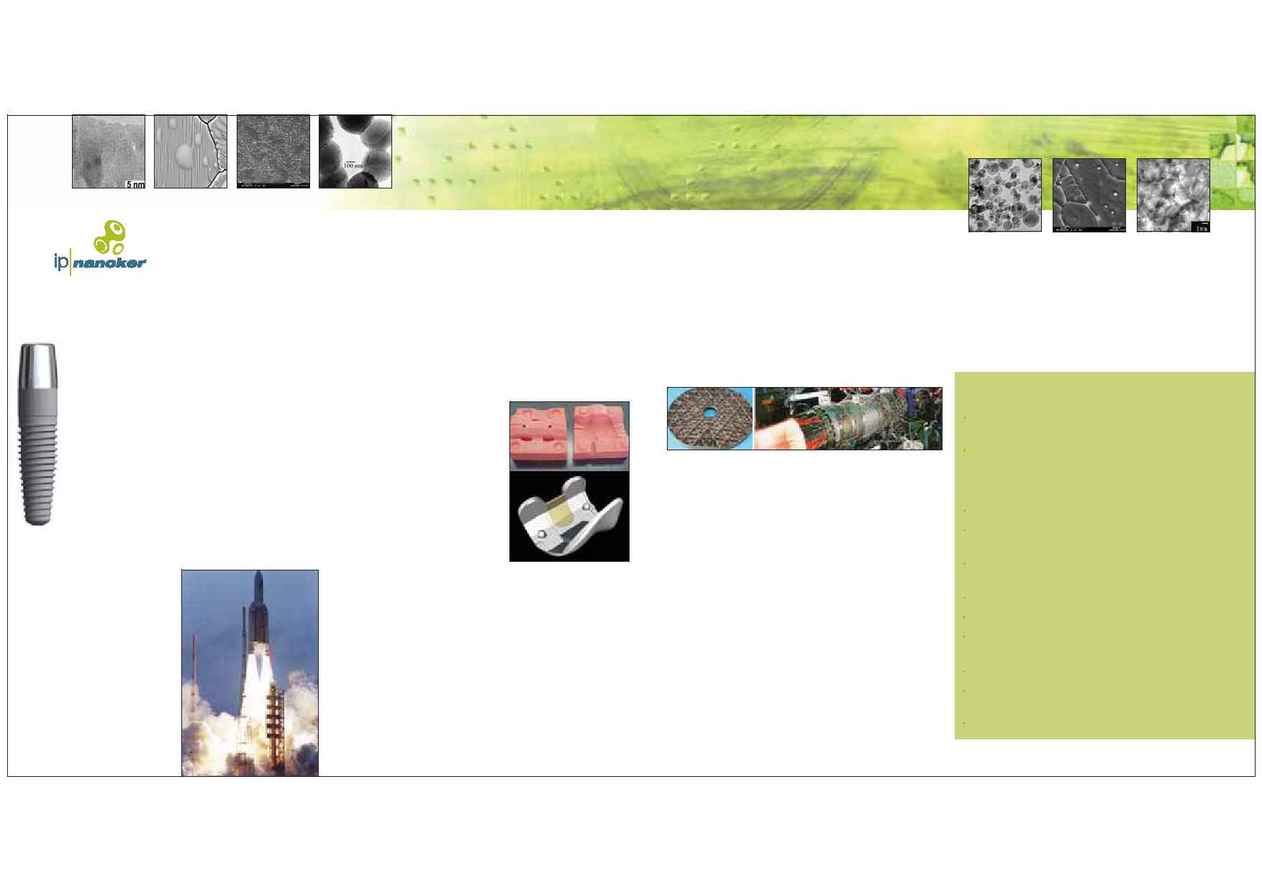
Advanced materials - currently used in industry - do not meet
the requirements demanded by the many technological
innovations which could provide major breakthroughs for our
society. This is basically because - up to now - it has been
impossible to combine in the same material an excellent
mechanical performance with the critical functionality necessary
for its application.
For example, the biocompatibility required for the ceramics used
for structural implants, has restricted the number of suitable
materials used to those such as alumina, zirconia and
hydroxyapatite. These ceramics have one common denominator:
their mechanical properties are not ideal for this type of application,
even though they possess the certain critical functional properties
not provided by tougher materials.
For advanced optical applications, such critical functionality could
be transparency. Glass is brittle, its low mechanical strength and
hardness make it useless for
applications such as aeronautics or
high power lightening elements, yet
is transparent. Due to their high
refractoriness, ceramics could also
meet the requirements of these
types of system, including
transparency. Up to now due to
production problems this has only
been possible using monocrystal
ceramics of limited size, and at an
astronomic price.
The design of new super-hard materials and nanostructured
coatings is a current challenge to scientists and engineers.
Thermal spraying deposition methods for fabrication of coatings and
free standing components from nano-sized particles are relatively low-
cost processes, suitable for large and relatively complex shapes.
However, a complete understanding of the chemical and physical
phenomena controlling the behaviour of these materials at the
nanometer scale is still lacking. For example, methods for the strict
control of grain size during plasma/particle interactions and the
subsequent solidification process, including the use of tailored
composition precursors still requires
extensive research.
Synthesis of super-hard materials needs
extreme conditions of high temperature and
pressure. Ceramics provide well known
advantages for cutting tools. However, some
of their intrinsic characteristics, such as their
low thermal conductivity limit the number of
candidates to few very expensive ones.
Wear resistance, mechanical strength (tensile
and, especially notch strength) hardness
and dense microstructure are some of the
crucial requirements for carbon based
components made for mechanical engineering and electronics
(bearings, seals, micro contacts, switches, polar plates). The tendency
to miniaturize these components as well as the requirements for longer
maintenance cycles have led to increasing requirements (higher loads
on smaller components over longer periods of time). Mechanical
resistance of current carbon based materials impose technical limits
which cannot be overcome without a radical change in both raw
material and shaping technology. A new research approach will lead
to better, faster and cheaper manufacturing of complex carbon parts
with improved mechanical and structural properties, shapes with
improved dimensional tolerances.
The industrial needs · the challenges of the project
17 industrial companies with 8 research centres and European
universities participate in this research project called "IP NANOKER
- Structural Ceramic Composites for Top-End Functional Applications"
co-financed by the European Commission within the VI Framework
Programme for Research within the area of "Nanotechnologies and
Nanosciences, Knowledge-based Multifunctional Materials and New
Production Processes and Devices".
This project has a total budget of nearly 19 million Euros lasting 4
years, from May 2005.
The objective of this Integrated Project (IP) is to find ceramic material
solutions which permit the industrial application of knowledge-based
nanoceramics (<100 nm) and nanocomposites (second phases <10
nm) for top-end functional and structural applications that are beyond
reach with incremental materials development alone.
"Nanocomposites" entirely made of ceramic and metallic nanoscale
particles or nanoscale phases, is a term that denotes a broad, new
class of engineered materials, where unique and otherwise
unattainable properties can be revealed. The industrial applications
of nanocomposites rely on the successful consolidation of these
materials which preserve their nanostructure. Traditional processing
techniques have strong limitations being unable to retain the nanoscale
grain size when using conventional nanoparticles as the starting
materials. That means that in addition to new material solutions, the
full added value chain of ceramic manufacturing has to be revisited.
NEW OPPORTUNITIES IN
THE DEVELOPMENT OF
NOVEL NANOSTRUCTURED
MATERIALS
25 partners from 11 countries
Newly created Nanomaterials as an Objetive
The final application of this new generation of ceramic components
will be made possible by the appropriate selection and design of the
microstructures by the material scientist, alongside appropriate
device concept design made by the material engineers plus
development of appropriate manufacturing technologies enabling
cost-effective industrialization.
IP NANOKER will carry out research activities in 15 specific fields
of industrial application:
Hip, knee, dental implants and heart valves with lifetimes superior
to those currently,
Bone substitutes which will allow the control of cellular and tissue
reactions adjacent to the implant via the introduction of biological
agents such as growth factors which will promote the formation of
osteogenic materials,
Radiation windows for satellite guidance,
Satellite mirrors with high stability and a surface roughness lower
than 7 anstron,
Coating systems of extreme hardness for the protection of optical
elements,
Polycrystalline lasers of high efficiency,
Components and nanostructured coatings for engines in aeronautics,
Conductive nanoceramic materials which can be machined by EDM
technologies,
Carbon nanostructured materials for fuel cells and microdevices,
Metal-ceramic materials of extreme hardness for cutting tools, and
finally,
High creep resistant nanostructured materials.
Results to be expected for industry
